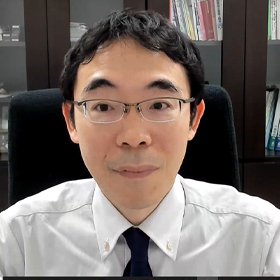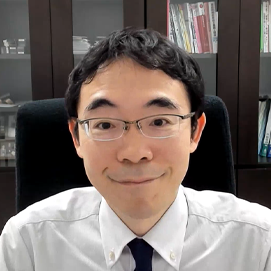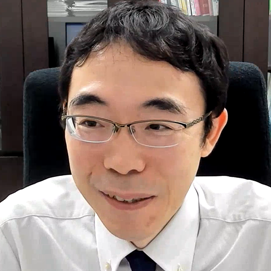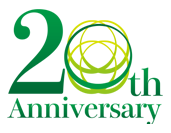Key person interview

I want to encourage them to move forward from Japan.
Professor, Department of Hematopoietic Cell Transplantation and Cellular Therapy
Professor Masahiro Inamoto
Question 1. Could you please tell us about your specialty?
My specialty is allogeneic hematopoietic stem cell transplantation. In cases where it is difficult to cure patients with malignant blood diseases using standard anti-cancer drug treatments, I specialize in transplanting hematopoietic stem cells provided by donors, using the power of the donor's immunity to cure intractable blood diseases.
Question 2. Regarding follow-up after hematopoietic stem cell transplantation, could you please tell me about the general course of the disease and management of side effects?
In allogeneic hematopoietic stem cell transplantation, first, pre-transplant treatment is performed to suppress the patient's original hematopoiesis and to suppress the tumor cells remaining in the body as much as possible. Pre-transplant treatment mainly consists of large amounts of anticancer drugs, but in some cases, total body radiation is also used. After undergoing pre-transplant treatment, patients experience mucosal disorders and a severe decrease in white blood cells, temporarily losing hematopoiesis, so they must endure this period by receiving blood transfusions and antibiotics almost every day. It usually takes 2 to 3 weeks for the donor's hematopoiesis to recover from the transplanted stem cells.
When hematopoiesis is restored, infections and mucosal disorders improve, but then the donor's immune cells react to the patient, starting an immune response. This response is what makes it possible to cure blood diseases that have been difficult to treat, but if the immune response is directed at the patient's body, it can cause a complication called GVHD (graft-versus-host disease), which damages the patient's organs. Therefore, treatment involves adjusting immunosuppressants to prevent GVHD from becoming too severe.
In most cases, complications such as GVHD will subside within 2 to 3 months after transplantation, allowing patients to be discharged from the hospital and return to regular outpatient care. Some patients may experience prolonged GVHD, which may necessitate continued use of immunosuppressants for a long period of time.
In addition to GVHD, transplant treatment can trigger various late complications throughout the body, such as diabetes, cholesterol abnormalities, secondary cancers that are not hematopoietic tumors, cataracts, and glaucoma. In order to properly manage these complications, it is important to follow up on patients in the outpatient department for almost their entire lives. Nowadays, there is a lot of knowledge about complications, and by following up properly, patients can maintain a high quality of life. After transplantation, we are in an era where the goal is not only to cure the disease, but also to improve the quality of life.
Question 3: Please tell us about any memorable experiences you had during follow-up, such as any difficulties or problems you encountered.
There are times when follow-up after transplantation can be difficult or troubling, but the most common is the aforementioned long-lasting GVHD (chronic GVHD), which shows symptoms similar to collagen disease. For example, patients can suffer from long-term discomfort, such as dry eyes, persistent pain in the mouth, hardening of the joints and skin, and persistent itchy skin due to persistent eczema. It is good news that new drugs for GVHD are being developed one after another, but I feel that this is an area where progress is still needed.
Another problem is that infections can be difficult. As the treatment involves maintaining a balance between immunosuppressants and a long-term state of immunodeficiency, patients may develop not only bacterial infections, but also fungal infections, which are caused by mold and viral infections. Because viral infections are greatly affected by the immune system, viruses that are not a problem in healthy people can become active after transplantation and cause infections, resulting in long-term problems for some patients. I think it would be good if such conditions could be improved in the future.
Question 4. Could you please tell us about the types of viral infections that occur after transplantation and their characteristics, such as clinical symptoms?
There are various types of viral infections after transplantation. First, the shingles virus causes painful blister-like eczema along the nerve distribution. It is very painful because it causes neuralgia. Currently, there is a drug called acyclovir as a preventive drug after transplantation, so the incidence is quite low. Next, cytomegalovirus has the characteristic that latent infections are reactivated when the immune system is weakened, and if it worsens, it can cause pneumonia or enteritis. Regarding this, too, there is now an effective preventive drug called letermovir, so the number of people who develop it is decreasing. In addition, there are drugs called ganciclovir and foscavir for treatment, and even if an infection develops, it can be cured in many cases.
The next most common type is adenovirus infection, which is well known as one of the causes of conjunctivitis in children, such as pool fever. In the case of post-transplant patients, infection of the bladder or urinary tract often leads to hemorrhagic cystitis. The symptoms begin with hematuria, followed by pain when urinating, frequent urination, and difficulty sleeping at night. If the condition worsens and progresses to a systemic infection, it can be life-threatening. There are currently no approved drugs for adenovirus infection in Japan or anywhere in the world, and in the event of an outbreak, the treatment policy is often to reduce the dose of immunosuppressants and increase the immune system as much as possible to cure the disease, but the current situation is that it takes time to cure the disease while battling the dilemma that reducing the dose of immunosuppressants too much will worsen GVHD.
Similarly, the BK virus is also a cause of cystitis, which can cause persistent hematuria and leave patients in a very difficult position; however, there are currently no approved drugs for treatment, even overseas, and I believe this is an area where further progress is needed.

Question 5. What are the current issues regarding post-transplant viral infections?
Regarding viral infections after transplantation, the most common are cytomegalovirus, followed by BK virus and adenovirus, but there are currently no effective treatments for adenovirus and BK virus anywhere in the world, including Japan. Therefore, I think there is a high demand for new drugs and new treatments for these areas where there are no treatments.
Question 6. We would like to hear your thoughts and opinions on the fact that SymBio Pharmaceuticals' injectable brincidofovir has established proof-of-concept* in a Phase II clinical trial for adenovirus infection after hematopoietic stem cell transplantation.

brincidofovir intravenous formulation has not yet been approved overseas, so SymBio Pharmaceuticals led a study abroad to determine the best dosage. The appropriate dosage was determined and the proof-of-concept was approved, which I think is a big step forward. I hope that the next study that will lead to approval of the drug will be conducted around the world, including in Japan.
*Proof-of-Concept (POC): POC refers to the process of verifying the efficacy of a new drug conceived during the research stage through actual preclinical study and clinical trials.
Question 7. Finally, what are your expectations for SymBio Pharmaceuticals in the future?
SymBio In the hematology area, the pharmaceutical company markets a drug called Bendamustine, which is a really indispensable drug for the treatment of patients with lymphoma, and I think it is a good drug with high efficacy. In the area of adenovirus infection, which is an area where there is no drug yet and needs to be developed, he is currently in charge of the development of a new drug called brincidofovir in the world. Although the number of patients in this field is rare, I have high expectations for SymBio, which is tackling a problem for which there is a high demand for development around the world.
